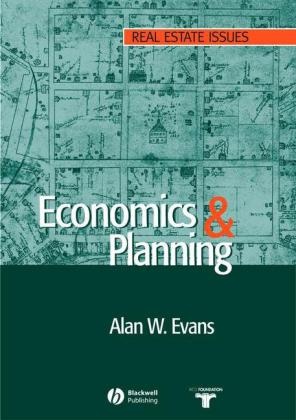Read more
Informationen zum Autor Alan Evans, Professor of Environmental Economics, Centre for Spatial and Real Estate Economics, School of Business, University of Reading. Klappentext What are the limits of land use planning and what are its objectives? Is the aim aesthetic? Is it efficiency? Is it to ensure quality? Or sustainability? And if it is all these aims, how should they be balanced against each other? This book addresses such questions through an analysis of the economics of land use planning and the relationship between economics and planning. It draws together the economics literature relating to planning and sets it out systematically. Over the past 20 years the economic analysis of land use planning has used positive economics to examine the unintended effects of planning and the way economic forces have affected planning. Public choice theory also plays a part in indicating the way planning has developed as the result of political pressures. The impact of planning is now so great that a full development is much needed. The book sets out the economic justification for land use planning as well as describing methods of assessing planning proposals and controls. It then presents a thorough analysis of the economic effects of the system and its 'political economy', looking at why planning takes the form it does. Economics and Land use Planning results from the 30 years of research, teaching and debate by the author. He writes in a crisp and clear style, simplifying the arguments without any loss of academic rigour. This thorough but accessible analysis will be valuable to students and researchers in real estate, land management, planning and urban economics. Zusammenfassung aeo Written in a crisp yet clear style aeo Simplifies arguments for the non--expert without loss of rigour aeo Product of research! teaching and debate by the author over 30+ years. Inhaltsverzeichnis Preface. Chapter 1 Introduction. Chapter 2 Market Failure and Welfare Economics - a Justification for Intervention. Chapter 3 Evaluation and Planning. Chapter 4 Controlling the Density of Development. Chapter 5 Zoning and conservation. Chapter 6 Green Belts, Growth Controls, and Urban Growth Boundaries. Chapter 7 Planning and the Land Market. Chapter 8 The Division of the Spoils: Profits, Planning Gain, Premium Seeking and Taxation. Chapter 9 Impact Fees. Chapter 10 The Economic Consequences of Higher Land Values. Chapter 11 The Macroeconomic Effects of Planning Constraints. Chapter 12 Methods of Planning. Chapter 13 Politics, Public Choice, and Political Economy. References. Index ...
List of contents
Preface.
Chapter 1 Introduction.
Chapter 2 Market Failure and Welfare Economics - a Justification for Intervention.
Chapter 3 Evaluation and Planning.
Chapter 4 Controlling the Density of Development.
Chapter 5 Zoning and conservation.
Chapter 6 Green Belts, Growth Controls, and Urban Growth Boundaries.
Chapter 7 Planning and the Land Market.
Chapter 8 The Division of the Spoils: Profits, Planning Gain, Premium Seeking and Taxation.
Chapter 9 Impact Fees.
Chapter 10 The Economic Consequences of Higher Land Values.
Chapter 11 The Macroeconomic Effects of Planning Constraints.
Chapter 12 Methods of Planning.
Chapter 13 Politics, Public Choice, and Political Economy.
References.
Index
Report
"Throughout the book Evans does a more than admirable job of explaining complicated issues with simple concise language supported by easy to follow diagrams." Regional Studies

